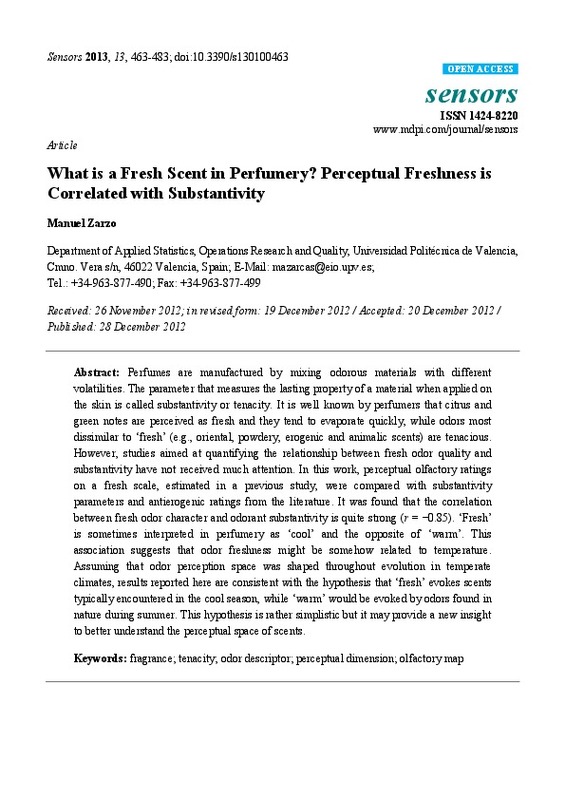Zarzo, M., & Stanton, D. T. (2009). Understanding the underlying dimensions in perfumers’ odor perception space as a basis for developing meaningful odor maps. Attention, Perception & Psychophysics, 71(2), 225-247. doi:10.3758/app.71.2.225
Rudolfi, T. A., Schedrina, M. M., & Mindlin, L. O. (1988). Determination of the evaporation rate of essential oils and perfumery compositions using gas chromatography. Chromatographia, 25(6), 520-522. doi:10.1007/bf02324825
Zarzo, M. (2008). Relevant psychological dimensions in the perceptual space of perfumery odors. Food Quality and Preference, 19(3), 315-322. doi:10.1016/j.foodqual.2007.10.007
[+]
Zarzo, M., & Stanton, D. T. (2009). Understanding the underlying dimensions in perfumers’ odor perception space as a basis for developing meaningful odor maps. Attention, Perception & Psychophysics, 71(2), 225-247. doi:10.3758/app.71.2.225
Rudolfi, T. A., Schedrina, M. M., & Mindlin, L. O. (1988). Determination of the evaporation rate of essential oils and perfumery compositions using gas chromatography. Chromatographia, 25(6), 520-522. doi:10.1007/bf02324825
Zarzo, M. (2008). Relevant psychological dimensions in the perceptual space of perfumery odors. Food Quality and Preference, 19(3), 315-322. doi:10.1016/j.foodqual.2007.10.007
Chastrette, M., Laumer, J.-Y. de S., & Sauvegrain, P. (1991). Analysis of a system of description of odors by means of four different multivariate statistical methods. Chemical Senses, 16(1), 81-93. doi:10.1093/chemse/16.1.81
The Rosace of Odors (Firmenich, 1972)http://membres.multimania.fr/sensonet/langa/rosace-firmenich.html
http://www.perfumerbook.com/ Scent%20Pyramid.pdf
Abe, H., Kanaya, S., Komukai, T., Takahashi, Y., & Sasaki, S. (1990). Systemization of semantic descriptions of odors. Analytica Chimica Acta, 239, 73-85. doi:10.1016/s0003-2670(00)83837-4
Chastrette, M., Elmouaffek, A., & Sauvegrain, P. (1988). A multidimensional statistical study of similarities between 74 notes used in perfumery. Chemical Senses, 13(2), 295-305. doi:10.1093/chemse/13.2.295
Wise, P. M. (2000). Quantification of Odor Quality. Chemical Senses, 25(4), 429-443. doi:10.1093/chemse/25.4.429
Teixeira, M. A., Rodríguez, O., & Rodrigues, A. E. (2010). Perfumery Radar: A Predictive Tool for Perfume Family Classification. Industrial & Engineering Chemistry Research, 49(22), 11764-11777. doi:10.1021/ie101161v
http://www-crnl.univ-lyon1.fr/documentation/olfaction/classification_des_parfums/sommaire.htm
Zarzo, M. (2011). Hedonic Judgments of Chemical Compounds Are Correlated with Molecular Size. Sensors, 11(4), 3667-3686. doi:10.3390/s110403667
Yokoyama, K., & Ebisawa, F. (1993). Detection and evaluation of fragrances by human reactions using a chemical sensor based on adsorbate detection. Analytical Chemistry, 65(6), 673-677. doi:10.1021/ac00054a004
Stevenson, R. J., & Boakes, R. A. (2003). A mnemonic theory of odor perception. Psychological Review, 110(2), 340-364. doi:10.1037/0033-295x.110.2.340
Ayabe-Kanamura, S., Schicker, I., Laska, M., Hudson, R., Distel, H., Kobayakawa, T., & Saito, S. (1998). Differences in Perception of Everyday Odors: a Japanese-German Cross-cultural Study. Chemical Senses, 23(1), 31-38. doi:10.1093/chemse/23.1.31
Chrea, C., Valentin, D., Sulmont-Rossé, C., Ly Mai, H., Hoang Nguyen, D., & Abdi, H. (2004). Culture and odor categorization: agreement between cultures depends upon the odors. Food Quality and Preference, 15(7-8), 669-679. doi:10.1016/j.foodqual.2003.10.005
Kirk-Smith, M. D., & Booth, D. A. (1987). Chemoreception in human behaviour: experimental analysis of the social effects of fragrances. Chemical Senses, 12(1), 159-166. doi:10.1093/chemse/12.1.159
Schaal, B., Marlier, L., & Soussignan, R. (1998). Olfactory function in the human fetus: Evidence from selective neonatal responsiveness to the odor of amniotic fluid. Behavioral Neuroscience, 112(6), 1438-1449. doi:10.1037/0735-7044.112.6.1438
Mennella, J. A., Jagnow, C. P., & Beauchamp, G. K. (2001). Prenatal and Postnatal Flavor Learning by Human Infants. PEDIATRICS, 107(6), e88-e88. doi:10.1542/peds.107.6.e88
Wallace, K. J., & Rosen, J. B. (2000). Predator odor as an unconditioned fear stimulus in rats: Elicitation of freezing by trimethylthiazoline, a component of fox feces. Behavioral Neuroscience, 114(5), 912-922. doi:10.1037/0735-7044.114.5.912
Rossiter, K. J. (1996). Structure−Odor Relationships. Chemical Reviews, 96(8), 3201-3240. doi:10.1021/cr950068a
Ferdenzi, C., Schirmer, A., Roberts, S. C., Delplanque, S., Porcherot, C., Cayeux, I., … Grandjean, D. (2011). Affective dimensions of odor perception: A comparison between Swiss, British, and Singaporean populations. Emotion, 11(5), 1168-1181. doi:10.1037/a0022853
Kobayakawa, K., Kobayakawa, R., Matsumoto, H., Oka, Y., Imai, T., Ikawa, M., … Sakano, H. (2007). Innate versus learned odour processing in the mouse olfactory bulb. Nature, 450(7169), 503-508. doi:10.1038/nature06281
Chrea, C., Grandjean, D., Delplanque, S., Cayeux, I., Le Calve, B., Aymard, L., … Scherer, K. R. (2008). Mapping the Semantic Space for the Subjective Experience of Emotional Responses to Odors. Chemical Senses, 34(1), 49-62. doi:10.1093/chemse/bjn052
PROST, C., GUEN, S. L., COURCOUX, P., & DEMAIMAY, M. (2001). SIMILARITIES AMONG 40 PURE ODORANT COMPOUNDS EVALUATED BY CONSUMERS. Journal of Sensory Studies, 16(6), 551-565. doi:10.1111/j.1745-459x.2001.tb00320.x
SCHIFFMAN, S., ROBINSON, D. E., & ERICKSON, R. P. (1977). MULTIDIMENSIONAL SCALING OF ODORANTS: EXAMINATION OF PSYCHOLOGICAL AND PHYSICOCHEMICAL DIMENSIONS. Chemical Senses, 2(3), 375-390. doi:10.1093/chemse/2.3.375
HARPER, R. (1975). SOME CHEMICALS REPRESENTING PARTICULAR ODOUR QUALITIES. Chemical Senses, 1(3), 353-357. doi:10.1093/chemse/1.3.353
Stoddart, D. M. (1986). The Role of Olfaction in the Evolution of Human Sexual Biology: An Hypothesis. Man, 21(3), 514. doi:10.2307/2803099
Ou, L.-C., Ronnier Luo, M., Sun, P.-L., Hu, N.-C., Chen, H.-S., Guan, S.-S., … Richter, K. (2010). A cross-cultural comparison of colour emotion for two-colour combinations. Color Research & Application, 37(1), 23-43. doi:10.1002/col.20648
[-]









